初中英语时间介词的用法小结
初中英语介词用法总结与归纳
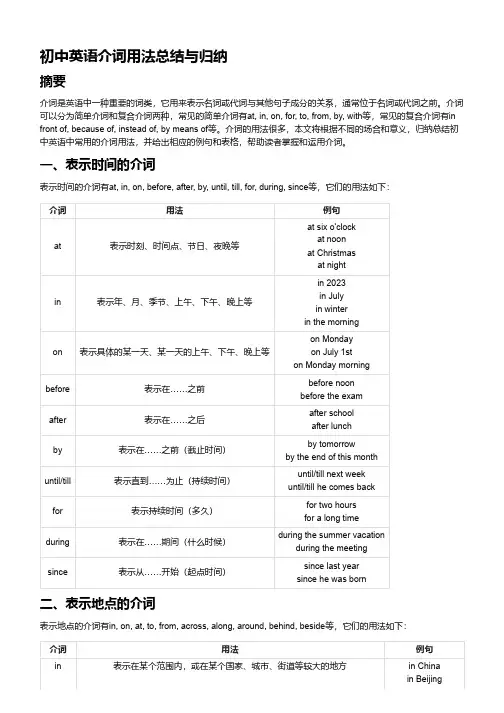
初中英语介词用法总结与归纳摘要介词是英语中一种重要的词类,它用来表示名词或代词与其他句子成分的关系,通常位于名词或代词之前。
介词可以分为简单介词和复合介词两种,常见的简单介词有at, in, on, for, to, from, by, with等,常见的复合介词有in front of, because of, instead of, by means of等。
介词的用法很多,本文将根据不同的场合和意义,归纳总结初中英语中常用的介词用法,并给出相应的例句和表格,帮助读者掌握和运用介词。
一、表示时间的介词表示时间的介词有at, in, on, before, after, by, until, till, for, during, since等,它们的用法如下:介词用法例句at表示时刻、时间点、节日、夜晚等at six o'clock at noonat Christmas at nightin表示年、月、季节、上午、下午、晚上等in 2023in Julyin winterin the morningon表示具体的某一天、某一天的上午、下午、晚上等on Mondayon July 1ston Monday morningbefore表示在……之前before noon before the examafter表示在……之后after school after lunchby表示在……之前(截止时间)by tomorrowby the end of this monthuntil/till表示直到……为止(持续时间)until/till next week until/till he comes backfor表示持续时间(多久)for two hours for a long timeduring表示在……期间(什么时候)during the summer vacation during the meetingsince表示从……开始(起点时间)since last year since he was born二、表示地点的介词表示地点的介词有in, on, at, to, from, across, along, around, behind, beside等,它们的用法如下:介词用法例句in表示在某个范围内,或在某个国家、城市、街道等较大的地方in Chinain Beijing介词用法例句in ZhongshanRoadon表示在某个表面上,或在某个楼层、台阶等较小的地方,或在某个方位上on the wall on the secondflooron the left/rightat 表示在某个具体的位置或地点,或在某个机构、场所等较小的地方,或表示靠近、附近等at the cornerat schoolat the bus stopto表示朝向某个方向或地点,或表示到达某个地点(范围之外)to the east to Japan to schoolfrom表示从某个地点出发或离开(范围之外)from home from Shanghai from Chinaacross表示横穿或穿过(从一边到另一边)across the street across the riveralong表示沿着或顺着(在一边)along the road along the riveraround表示围绕或环绕(在四周)around the lake around the worldbehind表示在……后面behind the door behind himbeside表示在……旁边beside the window beside her三、表示方向的介词表示方向的介词有to, from, into, out of, onto, off, up, down, through等,它们的用法如下:介词用法例句to表示朝向某个方向或地点,或表示目的地He is going to Beijing. She gave the book to me.from表示从某个方向或地点出发或离开,或表示来源He came from the south. This is a gift from my friend.into表示进入某个范围或空间(由外到内)He jumped into the water. She put the flowers into the vase.out of表示离开某个范围或空间(由内到外)He ran out of the room. She took the book out of the bag.onto表示移动到某个表面上(由低到高)He climbed onto the roof. She threw the ball onto the ground.off表示从某个表面上移开(由高到低)He fell off the bike. She took off her hat.up表示向上移动(由低到高)He went up the hill.介词用法例句She climbed up the ladder.down表示向下移动(由高到低)He came down the stairs. She slid down the slide.through表示穿过某个空间或物体(从一端到另一端)He walked through the forest. She looked through the window.四、表示方式、手段、工具的介词表示方式、手段、工具的介词有by, with, in, on等,它们的用法如下:介词用法例句by 表示交通工具、方式、方法等,或表示被动语态的动作执行者,或表示时间的截止点,或表示计量单位等by busby mistakeby himby tomorrowby weightwith 表示使用某种工具、器具、材料等,或表示伴随的人或物,或表示具有某种特征、状态等,或表示原因、理由等with a knifewith hisparentswith long hairwith joyin 表示使用某种语言、文字、颜色等,或表示穿着某种衣服,或表示处于某种状态、情况等,或表示在某种范围内等in Englishin black andwhitein a red dressin a hurryin generalon 表示使用某种电子设备、媒体等,或表示依靠某种力量、条件等,或表示以某种方式等,或表示参与某种活动等on TVon footon fireon dutyon holiday五、表示原因、目的、结果的介词表示原因、目的、结果的介词有for, at, from, of, with, by, because of, owing to, thanks to, out of, through等,它们的用法如下:介词用法例句for 表示原因、理由,常与sorry, famous, punish, praise, thank, blame等连用,也表示目的、意图,常与hope, wish, wait, look, come, go等连用,也可以表示用途、功能等for peacefor helpfor a walkfor funfor cutting paperat表示目的、意图,常与surprised, shocked, amazed, good, bad等连用,也可以表示针对、针对性等at his words at the news at math介词用法例句at solvingproblemsfrom 表示结果、效果,常与different, far, free, safe等连用,也可以表示来源、出发点等from the picturefrom now onfrom dangerfrom birthof 表示原因、理由,常与afraid, proud, sure, tired等连用,也可以表示所属、属性、特征等of the darkof himof the resultof his workwith 表示原因、理由,常与pleased, satisfied, angry, happy等连用,也可以表示伴随、方式、工具等with the answerwith himwith a smilewith a knifeby 表示方式、方法、手段等,也可以表示被动语态的动作执行者,或表示时间的截止点,或表示计量单位等by doing thisby himby tomorrowby weightbecauseof 表示原因、理由,相当于一个从句,后面接名词或代词等because of therainbecause of thatowing to表示原因、理由,相当于一个从句,后面接名词或代词等owing to the trafficjamowing to hisillnessthanks to表示原因、理由,含有感激或讽刺的意味,后面接名词或代词等thanks to yourhelp thanks to his carelessnessout of表示原因、理由,含有出于某种动机或感情的意味,后面接名词或代词等out of curiosity out of pitythrough表示原因、理由,含有经过某种过程或方式的意味,后面接名词或代词等through hard work through a window六、表示对象、范围的介词表示对象、范围的介词有of, for, about, with, to, from, among, between等,它们的用法如下:介词用法例句of表示所属、属性、特征等,也可以表示分离、脱离等the color of the skya cup of teaa friend of mineget rid of itfor表示目标、对象、受益者等,也可以表示目的、原因等 a gift for youa seat for twoa doctor for the poora room for rentabout表示主题、内容、话题等,也可以表示大约、左右等a book about history tell me about yourself about ten minuteswith表示伴随、陪同等,也可以表示方式、工具等stay with mea man with glasses speak with a loud voice cut it with a knifeto表示方向、目的地等,也可以表示对象、接受者等go to school fly to London say hello to him give it to herfrom表示来源、出发点等,也可以表示对象、对比者等come from Chinaa letter from my father different from youlearn from himamong表示在三个或三个以上的人或物之间(内部)share it among yourselves a flower among the grassbetween表示在两个人或物之间(内部或外部)sit between thema river between two mountains七、其他常用的介词除了上述介词外,还有一些其他常用的介词,如as, like, except, without, beyond, above, below, over, under等,它们的用法如下:介词用法例句as表示身份、职业、角色等,也可以表示方式、方法、程度等as a teacher as usual as you know as well aslike表示相似、类似等,也可以表示喜欢、喜爱等like a birdlike father, like sonI like music.except表示除……之外(不包括)everyone except me every day except Sundaywithout表示没有、缺少等without money without water without a wordbeyond表示超出、超过等beyond the wall beyond my expectation beyond controlabove表示在……之上(不接触)above the ground above sea levelabove allbelow表示在……之下(不接触)below the surface below zero below averageover表示在……之上(覆盖或接触)over the bridge over his head over the phoneunder表示在……之下(覆盖或接触)under the tree under his arm under the weather。
初中英语介词用法总结
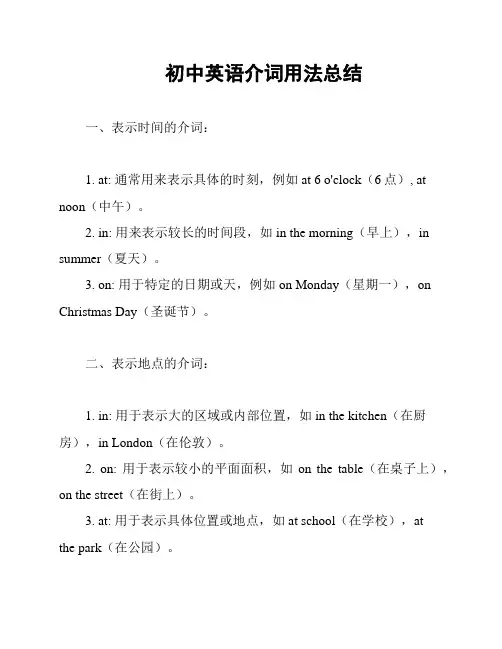
初中英语介词用法总结一、表示时间的介词:1. at: 通常用来表示具体的时刻,例如 at 6 o'clock(6点), at noon(中午)。
2. in: 用来表示较长的时间段,如 in the morning(早上),in summer(夏天)。
3. on: 用于特定的日期或天,例如 on Monday(星期一),on Christmas Day(圣诞节)。
二、表示地点的介词:1. in: 用于表示大的区域或内部位置,如 in the kitchen(在厨房),in London(在伦敦)。
2. on: 用于表示较小的平面面积,如on the table(在桌子上),on the street(在街上)。
3. at: 用于表示具体位置或地点,如 at school(在学校),atthe park(在公园)。
三、表示方式、方式、原因的介词:1. by: 表示通过某种方式或手段,如 by bus(乘公交车),by email(通过电子邮件)。
2. with: 表示伴随或使用某物,如with friends(和朋友一起),with a pen(用一支笔)。
3. for: 表示目的或原因,如 for fun(为了好玩),for the reason (因为...)。
四、表示动作方向的介词:1. to: 表示运动或行动的方向,如 go to school(去学校),send a letter to(寄一封信给)。
2. into: 表示进入某个内部空间,如 jump into the pool(跳进游泳池)。
五、表示关系和连接的介词:1. of: 表示所有关系,如 a photo of my family(我家的照片)。
2. with: 表示随同或具有某种关系,如 a girl with long hair(一位长发的女孩)。
3. to: 表示某种连接或关联,如 the key to the door(开门的钥匙)。
初一英语介词的用法归纳
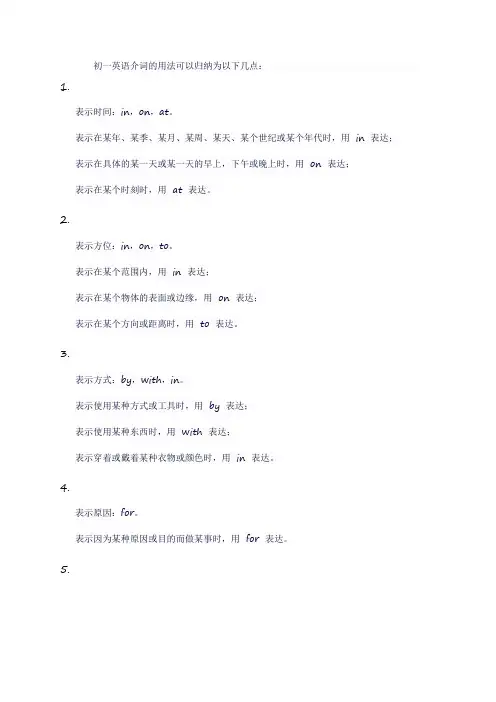
初一英语介词的用法可以归纳为以下几点:
1.
表示时间:in,on,at。
表示在某年、某季、某月、某周、某天、某个世纪或某个年代时,用in 表达;
表示在具体的某一天或某一天的早上,下午或晚上时,用on 表达;
表示在某个时刻时,用at 表达。
2.
表示方位:in,on,to。
表示在某个范围内,用in 表达;
表示在某个物体的表面或边缘,用on 表达;
表示在某个方向或距离时,用to 表达。
3.
表示方式:by,with,in。
表示使用某种方式或工具时,用by 表达;
表示使用某种东西时,用with 表达;
表示穿着或戴着某种衣物或颜色时,用in 表达。
4.
表示原因:for。
表示因为某种原因或目的而做某事时,用for 表达。
5.
表示除了:except,besides。
表示从整体中除去某部分时,用except 表达;
表示除了某人或某物外还有其他的时,用besides 表达。
以上是初一英语介词的用法归纳,需要强调的是,介词的用法是多样的,具体使用需要根据语境和上下文来判断。
因此,在学习介词时需要多加练习和运用。
初中英语知识点归纳介词的表示时间与地点
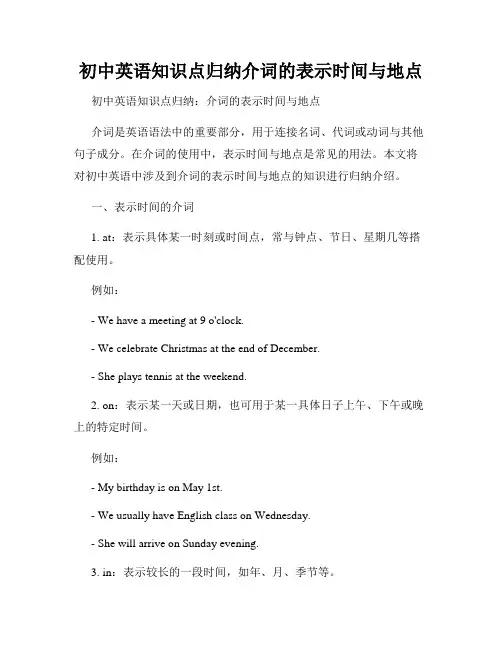
初中英语知识点归纳介词的表示时间与地点初中英语知识点归纳:介词的表示时间与地点介词是英语语法中的重要部分,用于连接名词、代词或动词与其他句子成分。
在介词的使用中,表示时间与地点是常见的用法。
本文将对初中英语中涉及到介词的表示时间与地点的知识进行归纳介绍。
一、表示时间的介词1. at:表示具体某一时刻或时间点,常与钟点、节日、星期几等搭配使用。
例如:- We have a meeting at 9 o'clock.- We celebrate Christmas at the end of December.- She plays tennis at the weekend.2. on:表示某一天或日期,也可用于某一具体日子上午、下午或晚上的特定时间。
例如:- My birthday is on May 1st.- We usually have English class on Wednesday.- She will arrive on Sunday evening.3. in:表示较长的一段时间,如年、月、季节等。
例如:- I was born in 2005.- He will go to Canada in the summer.- They always go skiing in January.4. during:表示在某一段时间内。
例如:- I read a book during the summer vacation.- They have a party during the New Year's holiday.5. for:表示持续的一段时间。
例如:- I have been learning English for five years.- They will stay in the hotel for a week.二、表示地点的介词1. in:表示在一个较大的范围或区域内。
时间介词的用法总结
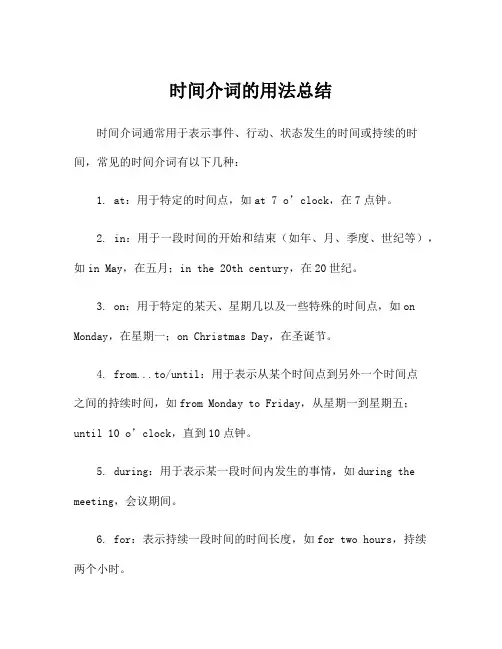
时间介词的用法总结
时间介词通常用于表示事件、行动、状态发生的时间或持续的时间,常见的时间介词有以下几种:
1. at:用于特定的时间点,如at 7 o’clock,在7点钟。
2. in:用于一段时间的开始和结束(如年、月、季度、世纪等),如in May,在五月;in the 20th century,在20世纪。
3. on:用于特定的某天、星期几以及一些特殊的时间点,如on Monday,在星期一;on Christmas Day,在圣诞节。
4. from...to/until:用于表示从某个时间点到另外一个时间点
之间的持续时间,如from Monday to Friday,从星期一到星期五;until 10 o’clock,直到10点钟。
5. during:用于表示某一段时间内发生的事情,如during the meeting,会议期间。
6. for:表示持续一段时间的时间长度,如for two hours,持续两个小时。
需要注意的是,有些时间介词在不同的情况下有着不同的含义,例如at在表示“在某个时间”的同时也可以表示“在某个地点”;in 在表示时间段的同时也可以表示“在某个地点”等等。
另外,虽然时间介词的用法比较固定,但还是要注意具体的语境和句子结构,尽可能准确和恰当地使用时间介词。
初中英语介词用法归纳整理
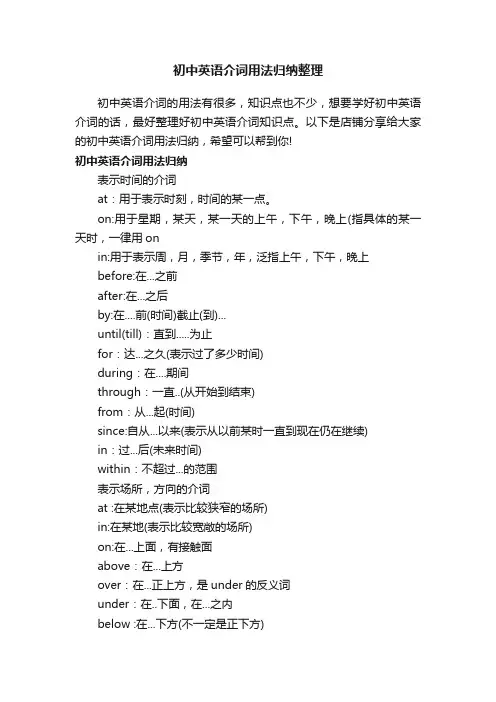
初中英语介词用法归纳整理初中英语介词的用法有很多,知识点也不少,想要学好初中英语介词的话,最好整理好初中英语介词知识点。
以下是店铺分享给大家的初中英语介词用法归纳,希望可以帮到你!初中英语介词用法归纳表示时间的介词at:用于表示时刻,时间的某一点。
on:用于星期,某天,某一天的上午,下午,晚上(指具体的某一天时,一律用onin:用于表示周,月,季节,年,泛指上午,下午,晚上before:在...之前after:在...之后by:在....前(时间)截止(到)...until(till):直到.....为止for:达...之久(表示过了多少时间)during:在....期间through:一直..(从开始到结束)from:从...起(时间)since:自从...以来(表示从以前某时一直到现在仍在继续)in:过...后(未来时间)within:不超过...的范围表示场所,方向的介词at :在某地点(表示比较狭窄的场所)in:在某地(表示比较宽敞的场所)on:在...上面,有接触面above:在...上方over:在...正上方,是under的反义词under:在..下面,在...之内below :在...下方(不一定是正下方)near:近的,不远的by:在...的旁边,比near的距离要近between:在两者之间among:在三者或者更多的之中around:环绕,在...的周围,在....的四周in front of:在...的前面behind:在...后边in:在..之内,用于表示静止的位置into:进入out of :和into一样,也表示有一定的运动方向along:沿着across:横过(平面物体)through:贯通,通过to :达到..地点(目的地)或方向for:表示目的,为了.....from:从...地点起其他介词with:和..在一起; 具有,带有; 用某种工具或方法in:表示用什么材料(例如:墨水,铅笔等)或用什么语言。
初一英语常见介词用法归纳
初一英语常见介词用法归纳介词是英语语法中非常重要的一部分,它在句子中起着连接和修饰的作用。
在初一英语学习中,介词的用法是一个非常重要的知识点。
以下是初一英语常见介词的用法归纳。
一、介词的基本概念介词是一种虚词,它通常位于名词或代词之前,用来表示名词或代词与其他词之间的关系。
介词通常根据其所表示的含义分为时间介词、地点介词、方式介词等不同种类。
二、常见的时间介词1. atat通常表示具体的时间点,如at 7 o'clock(在7点),at midnight(在午夜),at noon(在中午)等。
2. inin通常表示较长的时间段,如in the morning(在早晨),in the afternoon(在下午),in May(在五月)等。
3. onon通常表示某一天、日期或节日,如on Monday(在星期一),on New Year's Day(在元旦),on Christmas Day(在圣诞节)等。
4. sincesince表示从过去某一点开始的时间,如since 2010(从2010年开始),since Monday (从星期一开始)等。
5. forfor表示持续的时间段,如for three days(三天),for a week(一周),for two years(两年)等。
6. byby表示截止时间,如by 11 o'clock(到11点为止),by next Friday(到下周五为止),by the end of the month(到月底为止)等。
4. byby表示在某个位置或附近,如by the river(在河边),by the sea(在海边),by the park(在公园旁)等。
5. beside/besidesbeside表示在某个物体旁边,如beside the tree(在树旁),beside the lake(在湖边);besides表示除了……之外,如besides English, he can also speak French(除了英语,他还会说法语)。
中考介词归纳总结
中考介词归纳总结在中考中,介词是一个非常重要且常考的语法知识点。
介词在句子中起连接作用,表达时间、地点、方式、原因等关系。
掌握介词用法对于理解和运用英语至关重要。
本文将对中考所涵盖的常见介词进行归纳总结。
一、时间介词1. on:表示某一天或某一天的上午、下午、晚上等特定时间。
例:I will have a meeting on Monday.2. at:表示具体的时间点或特定的时刻。
例:We will meet at 9 o'clock.3. in:表示某一年、月、季节、时间段等。
例:She was born in 2005.例:We usually go swimming in summer.4. during:表示在某一段时间内。
例:He read a book during his summer vacation.二、地点介词1. at:表示具体的地点。
例:She is waiting for you at the bus station.2. on:表示表面或某物之上。
例:There is a book on the table.3. in:表示在某个范围、区域、国家或大洲内。
例:We live in a small town.4. to:表示朝向、方向。
例:He went to the library.三、方式介词1. by:表示通过某种交通方式或手段。
例:I usually go to school by bus.2. with:表示伴随、陪同。
例:She walks to school with her friends.3. in:表示用某种方式或手段。
例:He communicated with her in English.四、原因介词1. for:表示目的、原因或理由。
例:He went to the store for some milk.2. because of:表示因为。
初中英语知识点归纳介词的地点介词和时间介词的用法
初中英语知识点归纳介词的地点介词和时间介词的用法介词是英语中常见的词类,用于连接名词、代词或名词性短语与其他部分。
介词在句子中起到连接和修饰的作用,并且有不同的用法和意义。
本文将归纳介绍地点介词和时间介词的用法。
一、地点介词的用法1. in:用于表示“在……里面”、“在……范围内”。
- We live in a big house.(我们住在一幢大房子里。
)- There is a book in the bag.(书包里有一本书。
)2. on:用于表示“在……上面”、“在……表面”。
- The cat is sleeping on the table.(猫正在桌子上睡觉。
)- There is a cup of coffee on the desk.(桌子上有一杯咖啡。
)3. at:用于表示“在……处”、“在……的位置”。
- Tom is waiting for you at the school gate.(汤姆在学校门口等你。
)- We will meet at the restaurant.(我们会在餐厅见面。
)4. under:用于表示“在……下面”、“在……底下”。
- The cat is hiding under the bed.(猫躲在床底下。
)- The book is under the chair.(书在椅子下面。
)5. next to:用于表示“紧靠着……旁边”。
- My house is next to a park.(我的房子紧靠着一个公园。
)- The supermarket is next to the bank.(超市在银行旁边。
)6. between:用于表示“在……之间”、“位于两者之间”。
- The library is between the school and the hospital.(图书馆位于学校和医院之间。
)- The restaurant is between the bookstore and the cinema.(餐厅在书店和电影院之间。
初一英语常见介词用法归纳
初一英语常见介词用法归纳在学习英语的过程中,介词是一个非常重要的语法项目。
介词具有连接词与词之间关系的作用,在句子中承担着重要的语法功能。
下面就让我们来看一下初一英语常见介词用法的归纳。
一、介词的基本用法1.表示时间的介词at, on, inat用于表示具体的某一点时间,例如:at 7 o’clock(在7点钟),at the weekend (在周末);on用于表示具体的某一天或日期,例如:on Monday(在星期一),on May 1st(在5月1日);in用于表示一段时间,例如:in the morning(在早晨),in July(在7月)。
3.其它基本用法for, from, to, with, without, byfor表示目的,例如:for fun(为了好玩),for study(为了学习);from表示出发点或起点,例如:from Beijing(从北京出发),from Monday to Friday (从星期一到星期五);to表示方向或目的地,例如:go to school(去学校),walk to the park(步行到公园);with表示伴随,例如:go shopping with friends(与朋友一起去购物),play games with classmates(和同学们一起玩游戏);without表示缺少某物,例如:without money(没有钱),without help(没有帮助);by表示方式或交通工具,例如:by bus(乘公交车),by bike(骑自行车)。
1.介词+名词介词+名词构成介词短语,用来修饰动词、名词、形容词或整个句子,例如:in the library(在图书馆),with my friend(和我的朋友)。
2.介词+代词介词+代词构成介词短语,用来表示时间、地点、原因或目的,例如:in it(在它里面),at school(在学校)。
- 1、下载文档前请自行甄别文档内容的完整性,平台不提供额外的编辑、内容补充、找答案等附加服务。
- 2、"仅部分预览"的文档,不可在线预览部分如存在完整性等问题,可反馈申请退款(可完整预览的文档不适用该条件!)。
- 3、如文档侵犯您的权益,请联系客服反馈,我们会尽快为您处理(人工客服工作时间:9:00-18:30)。
初中英语时间介词的用法小结
表示时间的介词,在英语介词中占着相当重要的位置。
在初中阶段英语教学过程中,已出现了许多用来表示时
间的介词。
其中有:at on in during for to till un til after by before等。
本文着重谈一谈这些介词在
表示时间的用法及它们之间的同异之处。
1.at on in
a)at用来表示时间时,通常指时间的某一点。
例如:at five o’clock atnoon atmidnight
b)on用来表示某一段时间,特指某天或某天的上午下午或晚上。
例如:on Sunday,on October,on Satu
rday morning.
c)in也可用来表示一段时间,但多指长于一天或不到一天的时间段。
例如:inJanuary,insummer, in198
8, in the morning ,in the evening.
2.in与during
a)during用来表示一段时间,其意义大致相当于in的用法。
一般来说,凡是能用in的地方,也可以用d uring.例如:He came to see me during my abse nce.Don’t go to see his wife in his absence.
B)during与in的区别在于during强调时间的延续性,而in则只是一般指某一时间。
试比较:They vis ited many cities during their stay in China.Her grandpa was killed in the war.
3.in for during
a)“in+时间”与“for+时间”都可表示一段时间,但“for+时间”表示“有多久”,而“in+时间”
则表示“在何时”。
例如:We worked there for the winter.They worked there in winter.
以上两例中,in winter强调“在冬季”,不一定包括整个冬季时间,而for the winter则强调“整个冬天”。
b)for用来表示一般时间,常跟具体的时间段。
例如 for a few days for 3 weeks for five months等
4.since与after since与after
都可以用来引导表示从过去某一点开始的时间段词组。
它们的不同之处在于:
a)since引导的词组所表示的时间一直延续到说话时为止,因而要与现在完成时连用。
例如:He has bee n there twice since 1982.I have done nothing since six o’clock.
b)after引导的词组所表示的时间是纯系过去,并不延续到说话时,因此要和一般过去时连用。
例如:He went home after school.
5.till until与to
a)介词till/until常用于“from.……till/until”结构中,表示“一个动作的终结”。
介词to常用在“from.……to”的结构中,用来表示“一个阶段的终结”。
两者在这种结构中意义十分接近。
例如:The Am ericans stayed here from June to September.He studies from morning till/until night everyday.
b)to可用在表示钟点的词前。
我们说It’s six tofive 但不能说It’s six till/until five.反之在某些能用till/until的场合,却不能用to.例如:在“not.……until”结构中,我们说I didn’t go to be d till/until ten o’clock.却不能说I didn’t go to bed to ten o’clock.
c)till与until也有细微区别。
till常用在非正式文体或口语中,而until则常用于正式文体及比较正
式的场合。
另外,在句首多用until.
6.by before
a)by表示时间时,意思是“到……以前”、“不迟于”、“到……时(为止)”。
例如:by supper tim e by the end of last term
b)before表示时间,意为“在……以前”。
例如:before liberation the day before yesterday
c)by与before的区别在于,by短语表示时间,强调“终止点”,而before短语表示时间,强调“起始点”。
例如:Your son will be all right by suppertime.
句中的by suppertime表示从说话时到晚饭前这段时间。
而before构成短语则表示从某一时间或事件之
前,例如:The poor children couldn’t go to school before liberation.。
